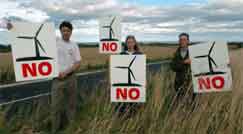The state of Iowa, it turns out, is a leading producer of electricity from wind power.
According to the American Wind Energy Association (AWEA), more than 36% of Iowa's in-state electricity production comes from wind, which has become one of the fastest-growing energy sources in the country. The Hawkeye state is in fact first in the nation in wind energy as a share of total electricity generated, second in installed wind capacity, and also second in the amount of money landowners make in lease payments, at more than $10 million a year.
What's not to love? Plenty.
In a very interesting article on Slate.com, Leah McBride Mensching paints a very interesting picture of the complexities and issues that go with large scale wind systems.
In one of several local anecdotes, Mensching notes that a new major wind turbine development is being built by RPM Access for utility MidAmerican Energy in the southeast corner of the state. There are already some 4000 turbines operating in Iowa.
Residents were not given opportunity to vote on the project. Instead, it was approved by the Mahaska County Board of Supervisors without direct approval from citizens in the county.
"We don't know where to go, we don't know what to do," one local resident told Mensching about the opposition she and others have to the project. "To us it seems like they just kind of slid in the back door and there's just nothing we can do about it."
Are we now faced with issues from what we might call Big Wind?
"The rapidly changing pace of technology, a dearth of regulation, and close ties between for-profit energy companies and state and federal governments handing out billions of dollars in production tax credits has created a system in which residents often feel left out of what's happening in - sometimes literally - their own backyards," Mensching writes.
As the TheGreenSupplyChain has written before, if you have not been up close to a wind farm, know this: they are very much industrial settings, with often hundreds of huge machines, even if they are sitting on some rural property in Iowa or anywhere else.
Which means living near to them may not be easy, especially for farmers trying to make a living from the land nearby.
A turbine, the article notes, doesn't affect just the few acres surrounding it. It has an impact on the entire farm it sits on, as well as neighboring farms.
The issues are many, Mensching says. Building and maintaining a turbine requires heavy equipment that damages tiles under fields, which affects drainage in surrounding fields. Drainage problems can hurt crop yields and even stop a farmer from being able to plant in the first place.
 A turbine also makes it more difficult, or sometimes impossible, for crop dusters to fly over fields around it in order to spray pesticides that protect their crops. Farmers also have concerns about their own safety, and the safety of the people they hire, having heard reports of turbines catching fire and throwing ice, even blades breaking off. A turbine also makes it more difficult, or sometimes impossible, for crop dusters to fly over fields around it in order to spray pesticides that protect their crops. Farmers also have concerns about their own safety, and the safety of the people they hire, having heard reports of turbines catching fire and throwing ice, even blades breaking off.
Mensching says there are also issues of "shadow flicker" and the noise turbines can make. Not only are both annoying, some say they can make you sick, though there is not yet much science behind that claim.
A key issue with the wind farms has to do with setbacks, the distance turbines must be kept from buildings, property lines, and roads. Mensching notes that farmers say if they had input on setbacks or could vote on where turbines were built, many of their problems would be minimized or eliminated altogether.
But instead, the farmers say feel outnumbered and out-financed by powerful energy companies, government officials, and green energy advocates, none of which seem to care much about their issues, Mensching says.
And then there is this dirty trick: locals who question the wisdom or details of plannec wind farms are frequently accused on being anti-environment and climate change deniers.
Some farmers have also been caught off guard by the details of the contracts. Those typically include a lot more than just leasing the land to place the turbines on. The contracts also require easements all around that land that usually include giving the developer the right to lay cables that connect the turbine to substations and the power grid; the right to use non-leased land in order to access the leased land to build, operate, and maintain the turbine; and the right to prevent landowners from doing anything on their property that may block the wind.
"It's not just an easement for your access road and this little bit here around these wind towers. It's the whole farm they've got easement to," Mensching quotes one farmer as saying. "So now there's a clause in there that says we can't plant a tree, build a building anywhere on that farm they've got easement to, because it might affect the wind."
And wind power is gaining momentum nationwide, likely to spur more of these issues. More than 40% more wind power projects nationwide are currently under construction or being developed than at this time last year, according to the AWEA.
TheGreenSupplyChain.com says that for all the benefits of renewable wind power, we don't want a wind farm in our backyard either. At minimum, citizens should be allowed to vote to approve or not a given projects, and concerns about setbacks and easement terms need to be much better addressed.
Should we have concerns about "Big Wind?" Do you side with the farmers or the wind companies and utilities? Let us know your thoughts at the Feedback button below.

|